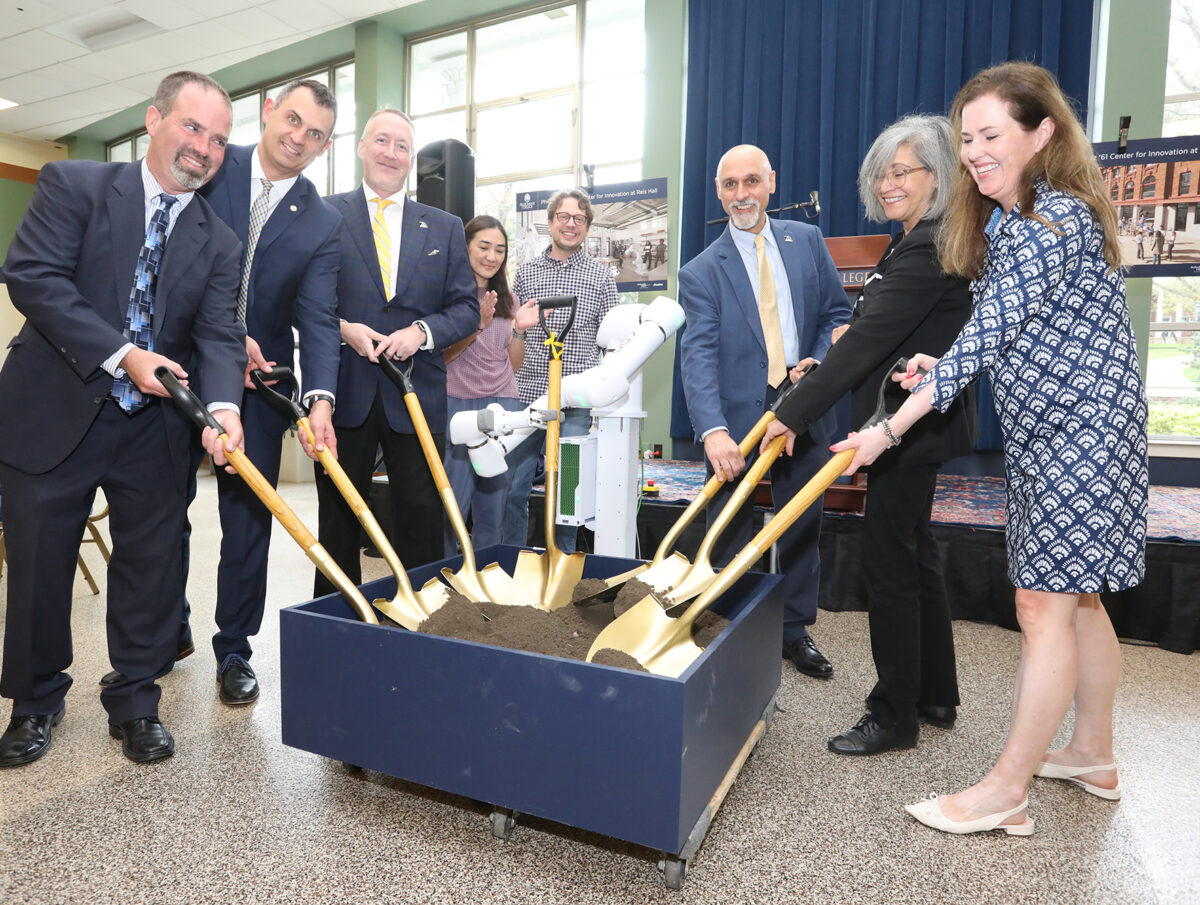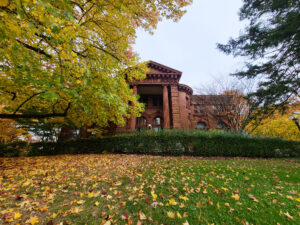
Allegheny College Celebrates Transformation of Reis Hall With Groundbreaking Ceremony
While the day started out rainy, the celebration moved inside as key leaders dug in to mark the groundbreaking ceremony held in Schultz Banquet Hall. The celebration marked the start of renovations to Reis Hall, which will transform the building into the Phil St. Moritz ‘61 Center for Innovation.
The St. Moritz Center for Innovation represents Allegheny’s long-standing academic excellence that embodies a collaborative, interdisciplinary approach to teaching and learning. Through the Center, students will learn and conduct research across disciplines, a hallmark of the Allegheny experience, all supported by technology developed for careers that span industries and prepare for careers of the future. By bringing together the Allegheny Lab for Innovation and Creativity (ALIC), the Department of Computer and Information Science, and a focus on interdisciplinary learning, Reis Hall will become an integral campus space for Allegheny students to learn and innovate.
Allegheny College President Ron Cole said, “This groundbreaking is symbolic of our commitment to academic excellence and innovation, our commitment to the region, and our vision for preparing our students for an ever-evolving world. Allegheny is leading at the intersection of liberal arts and emerging technology. Interdisciplinary learning is a key element in Allegheny’s approach to the liberal arts. Allegheny is one of the only colleges in the country that requires its students to major and minor in diverse academic areas to learn from multiple perspectives, building critical thinking skills and adding value to the learning experience.”
Allegheny’s Computer and Information Science department, one of the first programs of its kind at a liberal arts college, has evolved to include a spectrum of areas, including robotics, software engineering, and artificial intelligence. As a model of interdisciplinary studies, the curriculum expands to integrate a number of other disciplines to deliver education in:
- informatics, to prepare students to use the power of information to solve pressing challenges
- art and science, to teach cultural innovation
- computing ethics, to instill responsibility, perspective, and problem-solving to make a positive impact on the world
Through the ALIC, students and faculty are empowered to imagine, design, and build artistic projects, robots, prototypes of scientific equipment, video games, smart devices, and more in a facility equipped with an array of sophisticated digital equipment. In partnership with the ALIC @ Bessemer location, this work further brings the educational mission of Allegheny College directly to community and industry partners to equip our regional workforce to adapt to emerging technological development and advances in business operations.
This project will be funded through the estate of Phil St. Moritz ’61, funding from the state Redevelopment Assistance Capital Program (RACP), and other donors.

History of Reis Hall
Reis Hall is one of the most iconic buildings of Allegheny College, situated in the very center of campus. Most notably, until 1976, Reis was home to one of the largest libraries of any college, a collection that in its earliest days caught the eye of Thomas Jefferson and John Quincy Adams. Wanting to usher in the twentieth century with a building symbolic of learning, President William Henry Crawford (1893-1920) undertook the construction project in the late 1890s with several donors and a pair of design possibilities in mind.
Eventually, it was W.E. Reis, president and partner of Shenango Valley Steel Co., who agreed to fund the project, but only if his donation was kept anonymous. At the end of his presidency, Crawford convinced the donor to go public, and the building formerly known simply as “The Library” was renamed the William Edward Reis Library in honor of this generous donation.
A rotunda design was created by architect Charles W. Bolton, based on the Nicholas Murray Butler Library at Columbia University and evoking Thomas Jefferson’s Rotunda at the University of Virginia. Its exterior combines features of Beaux-Arts and Italian Renaissance styles, while the open interior creates an elegant and well-lit space for reading. In 1929, a three-level addition was added to the north face of the library for the ever-expanding collection. A grand staircase led to the reading room and provided a focal point for the rotunda.
Much like the original library housed in Reis was elite in stature, the repurposing of Reis and the dynamic programs it will house will assist Allegheny College in recommitting to its contributions to the region.
About Allegheny College
Allegheny College, founded in 1815, is one of the nation’s most historic and innovative four-year colleges, with the unique requirement of completing a major and minor in different academic areas. This multidisciplinary learning breaks the conventional mold to provide creative, independent thinkers with a path for educational depth and intellectual growth, preparing them for careers that may not yet exist. Located in western Pennsylvania, Allegheny College is one of 40 colleges featured in Loren Pope’s “Colleges That Change Lives.” In its 2024 rankings, U.S. News & World Report recognized Allegheny College as one of the country’s top 100 national liberal arts colleges — and one of the top 25 best for undergraduate research and creative activities.